Whether the warmer months are behind you, you’re home sick with a cold, or you’re just looking for a warm appetizer before the main course, let’s face it: a warm bowl of miso soup is always a great idea! Its unique flavor is downright comforting, however you spin it. And you might be surprised to learn just how many ways there are to make homemade miso soup.
Even if this is your first time making miso, worry not. We’ll give you step-by-step instructions on how to make 4 different miso soup recipes. Choose the kind of miso that fits your timeframe! From the 1 minute recipe, to the more authentic miso soup version with homemade dashi broth and miso paste, we’ve got you covered.
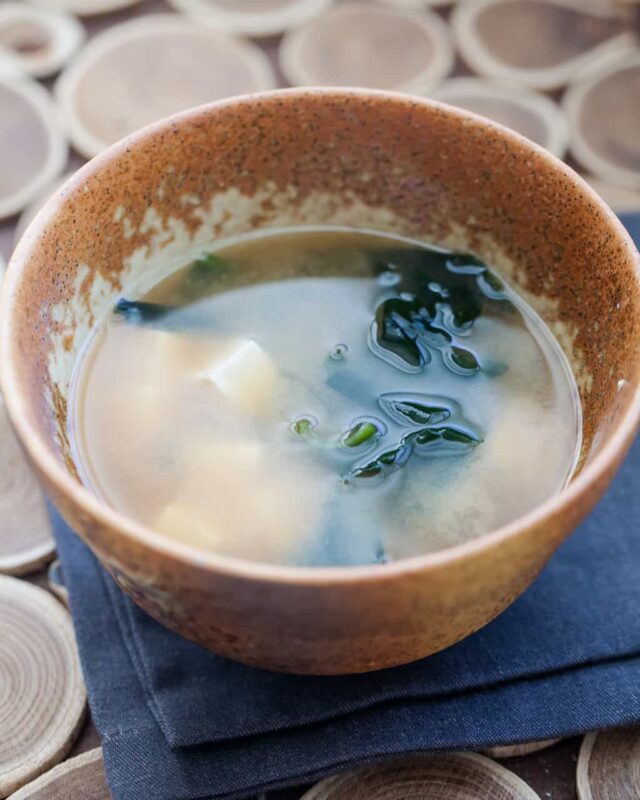
Why These Miso Soup Recipes Are So Good
- You control the level. Choose from a super quick easy miso soup recipe using simple ingredients to the traditional recipe of making miso from scratch utilizing a variety of ingredients
- This creamy miso soup is refreshing and delicious
- Classic Japanese flavors
- Health benefits: because miso goes through a fermentation process, it provides the gut with beneficial bacteria
Main Ingredients
There are 2 main ingredients in any classic miso soup: Dashi and Miso Paste.
- Dashi (pronounced DAH-shee) is the most fundamental ingredient in Japanese cooking. It is the basis of almost every traditional Japanese soup, as well as sauces and simmering broths. Dashi is made of seaweed (kombu kelp) and smoked & dried fish (bonito flakes).
- Miso is made from soybeans, rice and/or barley. Salt is added and then the mixture is fermented. The result is a savory, salty, umami-rich paste that can be used to make miso soup, miso ramen, salad dressings, marinades (try Miso Salmon recipe).
After you have the basic miso soup, you can add various toppings: green onions, tofu, seaweed, shiitake mushrooms, clams, leeks, noodles or any vegetables.
How To Make Miso Soup – Step By Step
- Wipe the kombu clean with a paper towel. Add the kombu and water to a sauce pan. Bring to a boil over medium-low heat. When water just begins to boil, remove the kombu.
- Bring the kombu water to full boil. Add the katsuobushi all at once. Boil for 60 seconds. Turn heat off and let sit, undisturbed for 10 minutes.
- in the meantime, dice the tofu. Soak dried wakame in water until expanded. drain and discard water.
- After steeping katsuobushi, the flakes will sink to bottom of pot. Strain the katsuobushi through cheesecloth.
- Return dashi to a simmer and immediately turn off heat. Whisk in miso paste. When miso has fully dissolved, add tofu and wakame.
Super Quick 1-Minute Miso Soup
The simplest way to make miso soup is with a ready-made mix. Inside the package, there are 3 packets of instant miso soup. Open a packet, dump the powder and freeze-dried tofu cubes into a bowl. Stir in hot water. Done!
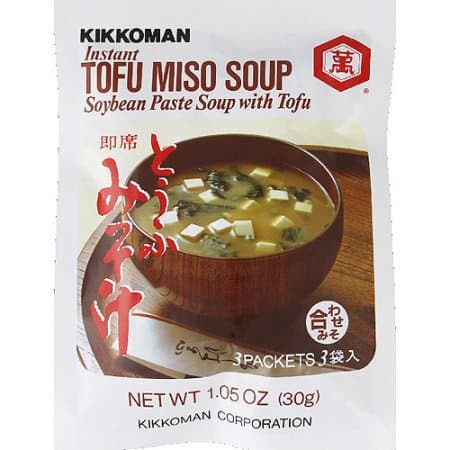
Kikkoman is the most well-known and widely available brand of instant miso soup, but it’s not the best.
If you’re near an Asian market, especially one with lots of Japanese ingredients, look for a package of instant miso that contains miso paste packets, like this, from Marukome brand.

This particular package on the left contains 32 packets of instant miso (each serves 1). The one on the right has 5 servings. Both of these packages offer different miso soup toppings and flavors.
The one I have has 24 servings (see below). There are 24 miso paste packages (the smaller packets in blue), and several different toppings: tofu, green onion, seaweed, bean curd, etc.
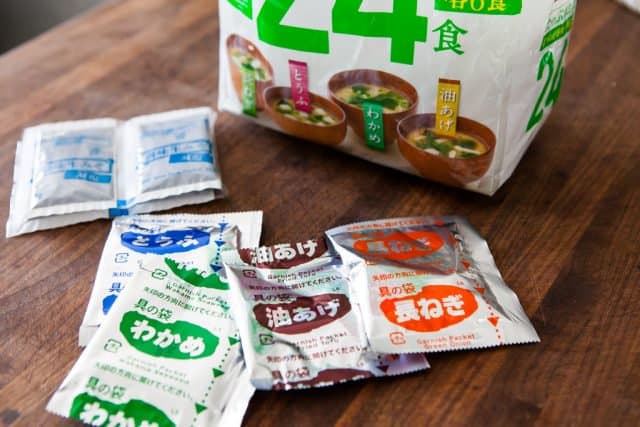
These miso paste packets are so much better tasting than the miso powder from Kikkoman!
Most of these brands have packages that are all in Japanese. If you can’t read Japanese, pick up the package. If it feels heavy, then it likely contains miso paste. If the package feels relatively light, then that generally means the miso is just powdered.
How to Make 1-Minute Miso Soup
- Microwave 1 cup of water for 1 minute.
- Mix in packet.
3-Minute Miso Soup
Making miso soup in 3 minutes only requires 1 ingredient: Miso paste that is already mixed with dashi. It looks exactly like regular miso paste, and you wouldn’t be able to tell the difference between the two, unless you read the package.
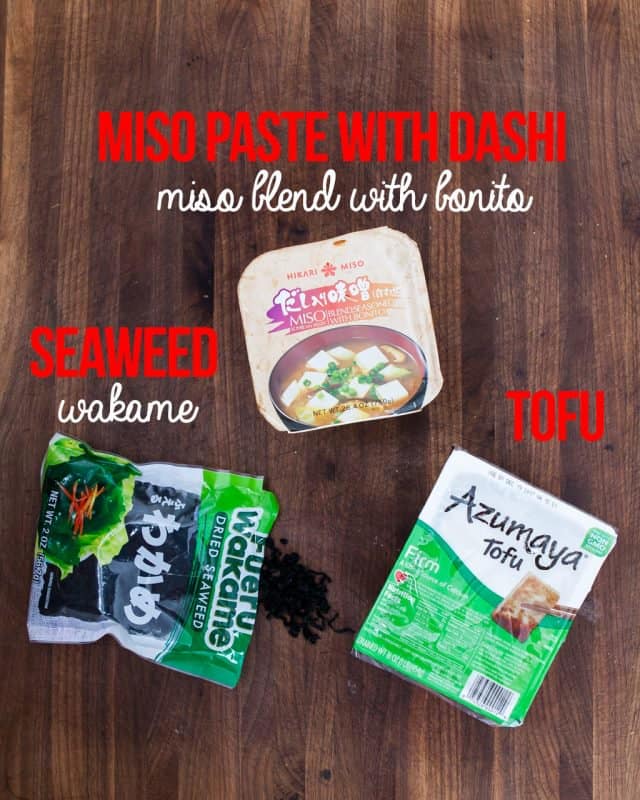
Since the dashi (or bonito) is already in the miso paste, all you need to do is whisk in hot water for basic miso soup. Add in diced tofu and dried seaweed (wakame).
What is Wakame?
Seaweed used for miso soups and salads is called wakame, pronounced wah-KAH-meh.
Wakame is sold in dried form. All you need to do is soak the dried wakame in water for a couple of minutes. Once rehydrated, it will expand!

Soak in cold water for 5 minutes, or hot water for 1 minute. Drain, and then add to miso soup. All you need is just a pinch of dried wakame for each bowl. You’ll be surprised how much it expands! This was 1 teaspoon of dried wakame:
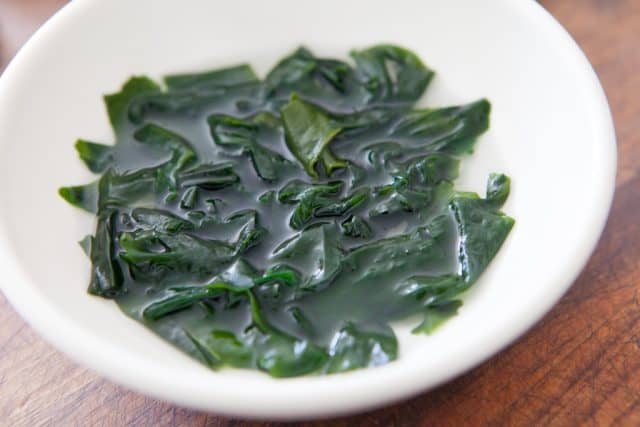
How to Make 3-Minute Miso Soup:
- Soak wakame in water, drain.
- Cut up tofu into small cubes.
- Boil water, turn off heat. (or microwave 1 cup water for 1 minute)
- Whisk miso/dashi paste into hot water.
This nifty tool is a miso tool. It not only measures out miso paste, but it also serves as a whisk (here’s another one on Amazon). One end is 1 teaspoon, the other end is 1 tablespoon. For 1 small bowl of miso, I use 1 teaspoon of miso/dashi paste, depending on your personal preference. For stronger tasting miso soup, you can use 1 tablespoon. But I like my miso soup on the light side.
Stick the miso tool into the miso paste and twist a bit. The perfect amount of miso will end up in the whisk!
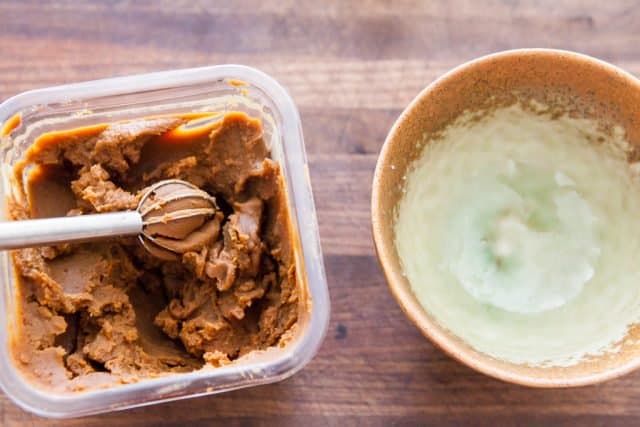
Just whisk in the hot water. As you whisk, the miso will dissolve.
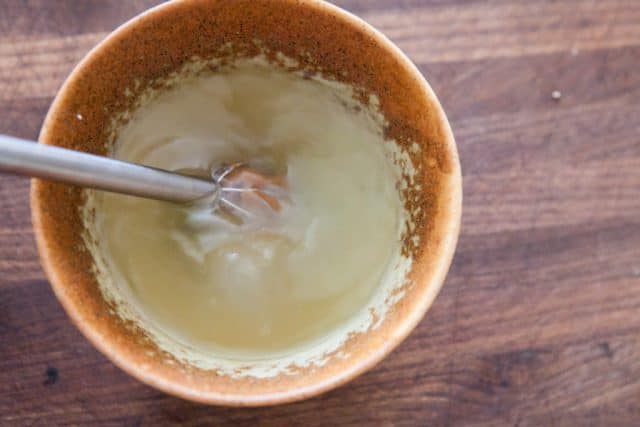
Add in the tofu and drained wakame.
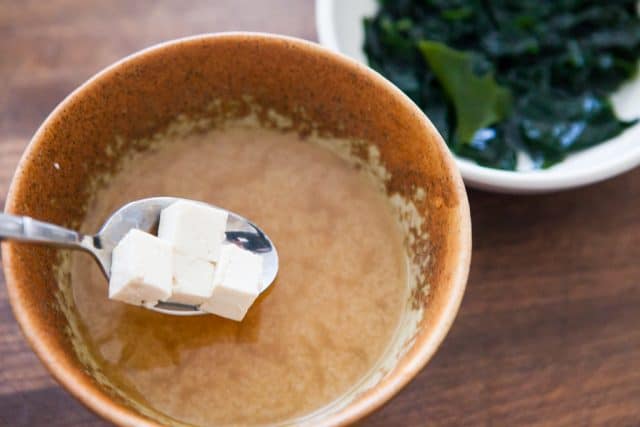
Your miso soup is ready in just 3 minutes.
4-Minute Miso Soup
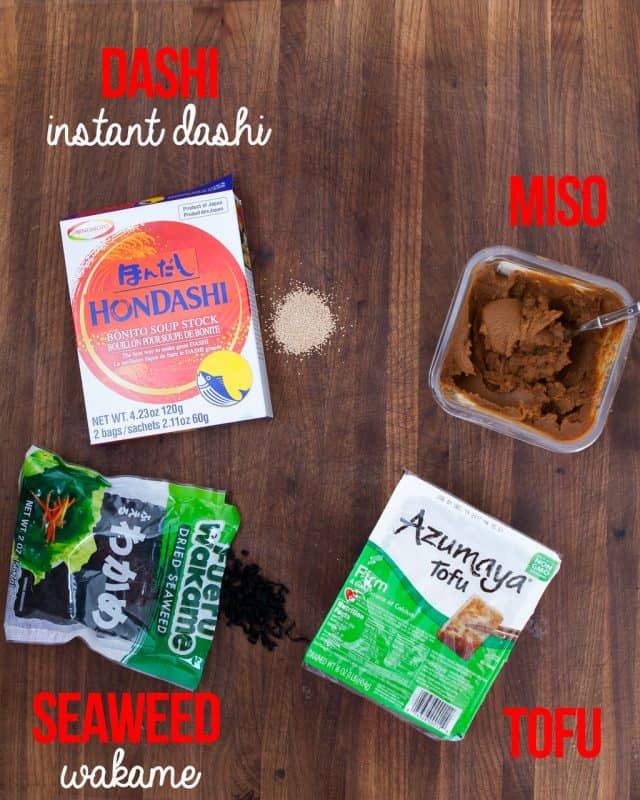
Another version of fast miso soup uses instant dashi, in the form of little dashi granules. Think of it as Japan’s version of chicken bouillon. Very little instant dashi is used: 1 teaspoon for every 2 cups of water.
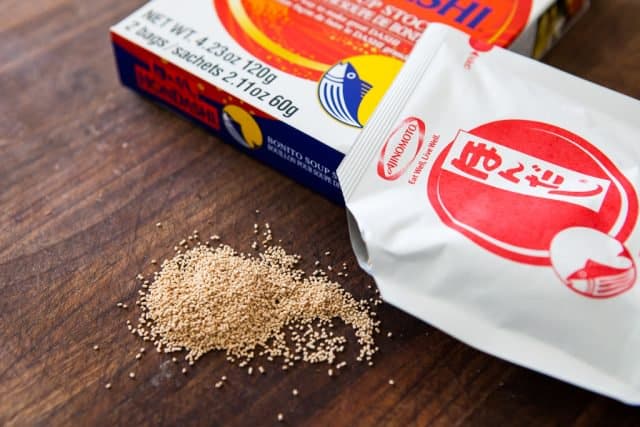
There is MSG in instant dashi, but very little instant dashi is used in miso soup. Personally, I’m very sensitive to MSG, but using this instant dashi (especially this brand called Hondashi) does not affect me at all.
Other uses for instant dashi: When boiling or blanching vegetables, I’ll add a teaspoon to the cooking water for an extra boost in flavor. I love adding instant dashi to the water when I’m boiling edamame to snack on.
How to Make 4 Minute Miso Soup
- Cut up tofu.
- Soak wakame, drain.
- Boil water, turn off heat.
- Whisk in instant dashi (1 teaspoon: 2 cups water)
- Whisk in miso paste (2 tablespoons: 2 cups water)
20 Minute Miso Soup: Miso Soup from Scratch
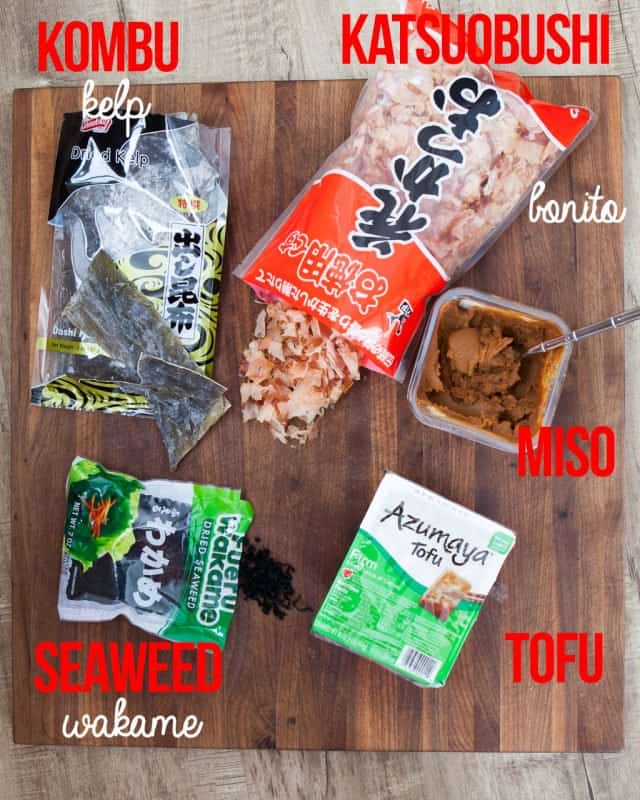
To make miso soup from scratch, you’ll need to make dashi, which is a combination of kombu (large, dried seaweed/kelp) and katsuobushi (smoked, dried skipjack tuna fish shavings).
What is Kombu?
Kombu is sold dried, in large pieces or sheets. Kombu is cultivated in Hokkaido (northernmost island in Japan), Korea and China. It adds loads of umami flavor with its natural glutamates. No MSG is needed when you use kombu!
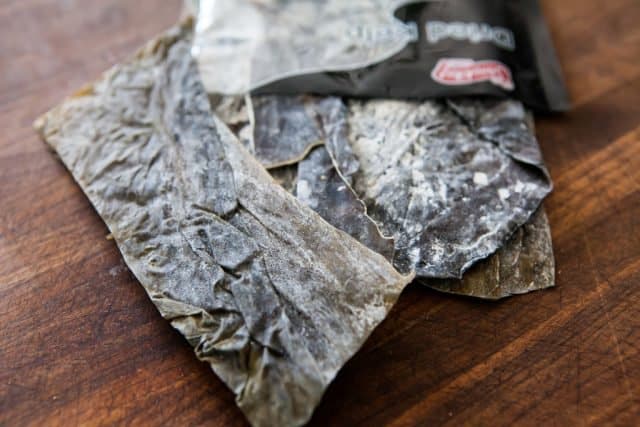
If you’re making a pot of miso soup for 4 people, you’ll need a piece of kombu approximately 4″x6″ size.
Gently wipe the kombu with a dry cloth or paper towel, to wipe away any dirt. Don’t try to wipe away the white powder on the kombu, which is natural crystalized minerals and provides flavor and nutrients to your dashi stock.
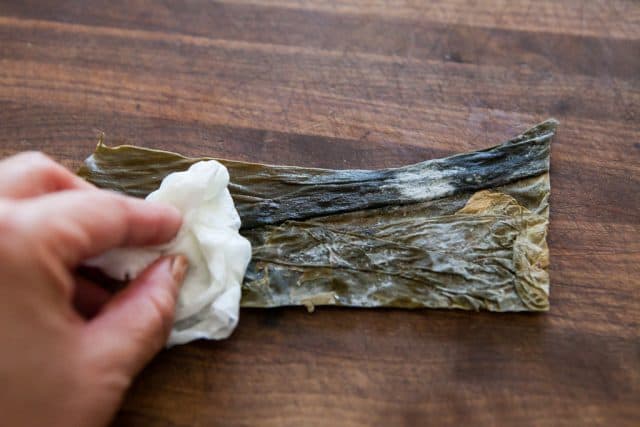
What is Katsuobushi?
Katsuobushi is made from skipjack tuna (bonito) that is smoked, dried, then shaved into ultra feather-light pieces.
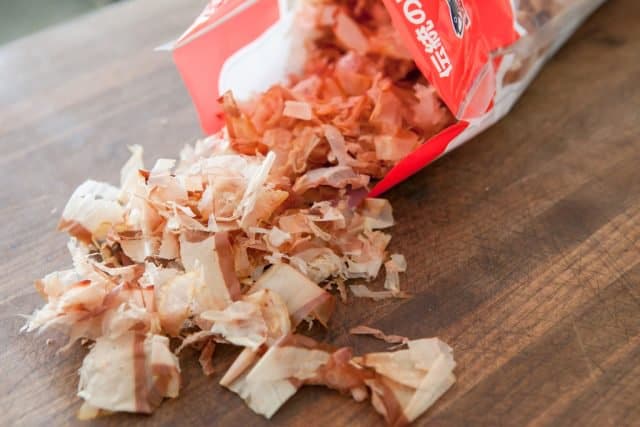
Making Dashi From Scratch
Add a 4″ x 6″ piece of kombu to cool water. Turn heat to medium-low and bring to a boil. Keep the heat medium-low!
Note: for best flavor, you can soak the kombu for 30 minutes or up to overnight in cool water before bringing to a boil. But, if you’re making miso soup in 20 minutes, there’s no need to soak for more than a couple of minutes, which is the time it takes to bring the water to a boil.
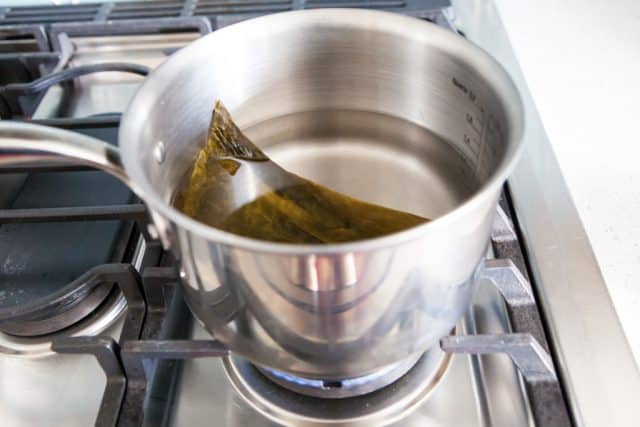
When the water is just about to boil, remove the kombu.
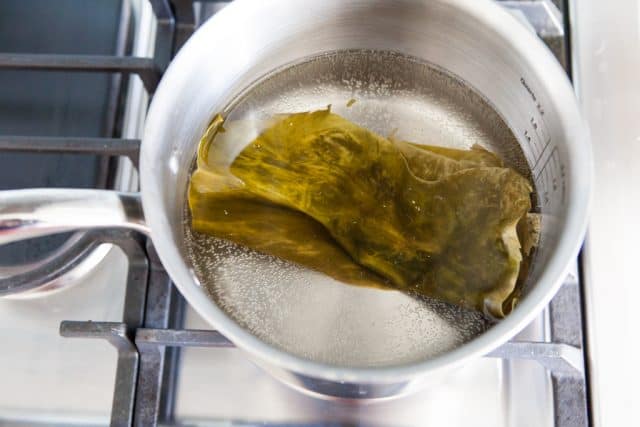
Don’t boil the kombu! Boiling kombu will make the dashi cloudy and strong smelling. Just remove the kombu when you see little bubbles coming up to the surface of the water.
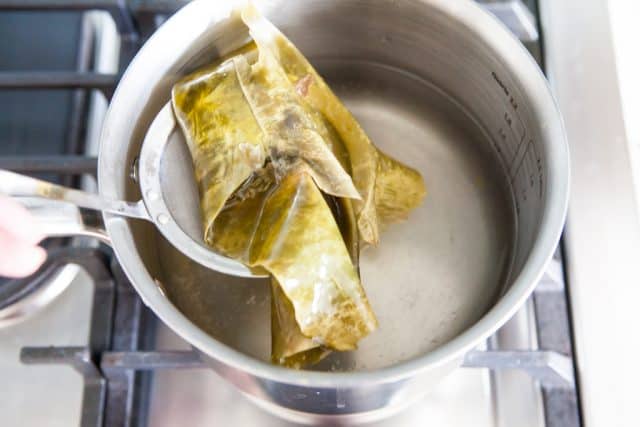
Don’t discard the used kombu! Just put on a clean plate, and let dry. You can re-use kombu to make another batch of dashi (secondary dashi), or cut up and eat. There is a ton of nutrition in the kombu!
After removing the kombu, bring the water to a boil. Once the water is boiling, add a handful of katsuobushi.
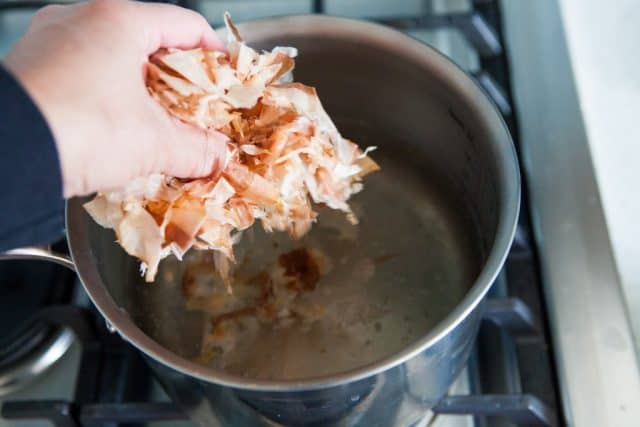
Boil for a minute.
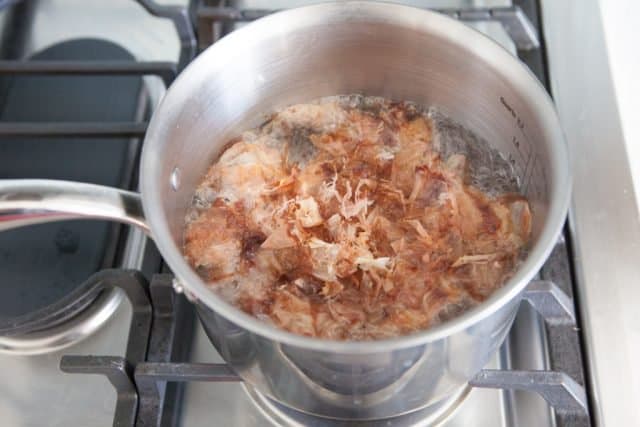
Then turn off the heat, and let the bonito sit, undisturbed to steep for 10 minutes. If you boil the bonito for too long, the dashi will smell very strong (fishy).
After a couple of minutes, the katsuobushi will naturally sink to the bottom. Do not stir the bonito! If you stir the bonito around, the dashi will become cloudy.
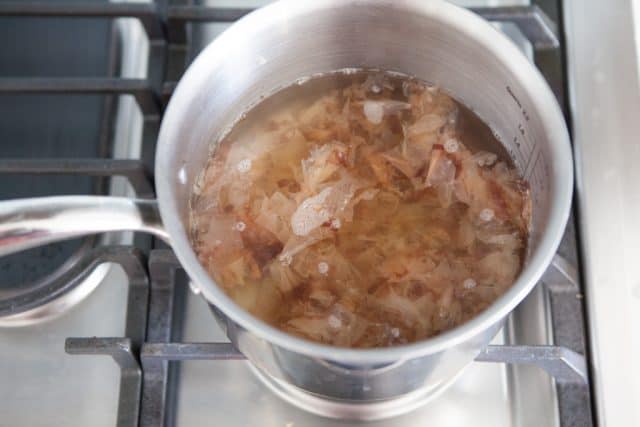
Once all the katsuobushi has sunk to the bottom, strain the katsuobushi out. It’s best to pour the dashi through a fine mesh strainer and cheesecloth or clean handkerchief.
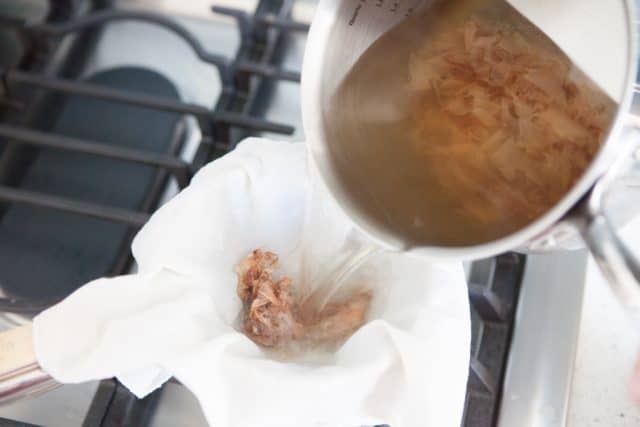
Sure, you can use a fine mesh strainer to fish out the katsuobushi, but it will take a long time, and in the process you risk stirring up the katsuobushi too much (causing the dashi to become cloudy).
The spent katsuobushi (along with the used kombu) can be re-used to make secondary dashi, which is a weaker tasting dashi that can be used for many Japanese dishes. Just simmer the katsuobushi and kombu for 10 minutes, then strain.
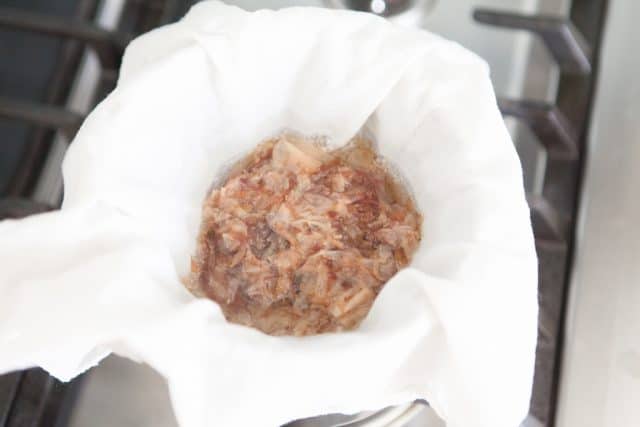
Dashi complete!
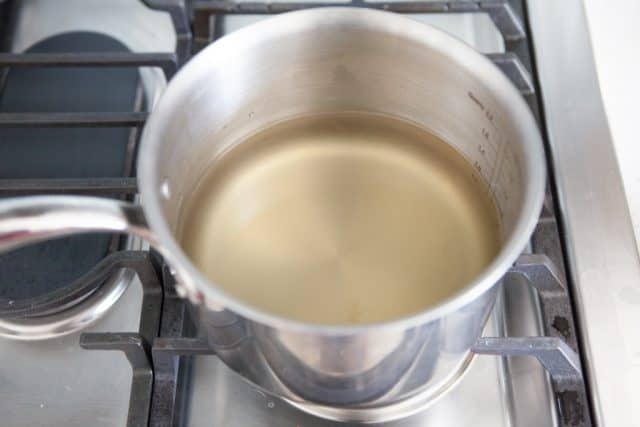
Bring the dashi to a boil. Then immediately turn off the heat to whisk in the miso paste. Do not boil the miso paste, which will make the miso soup gritty, and destroy the probiotics found in miso.
We’re making miso soup for 4 people, so I like to use about 3 tablespoons of miso paste. If you don’t have a small miso whisk (in the 3-Minute Miso Soup section), just use a regular whisk and grab about 3 tablespoons of miso. No need to be exact. You can taste the soup and add more, if needed.
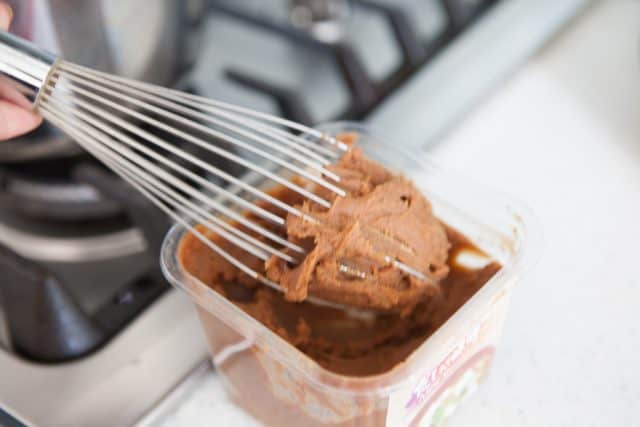
Whisk the miso directly into the dashi stock.
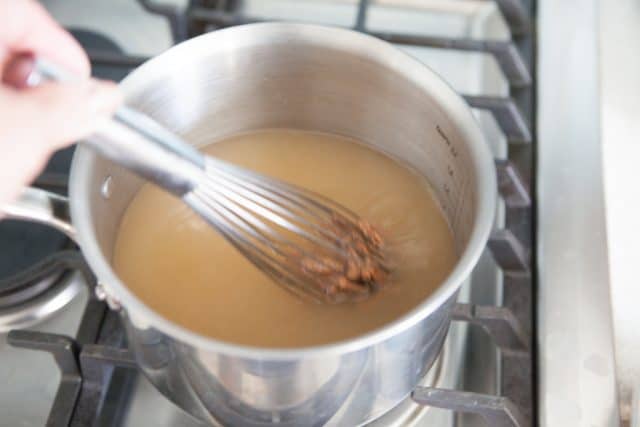
After all the miso has dissolved, you can add tofu and wakame to the pot, or just add them to the bowls and ladle miso soup into each bowl.
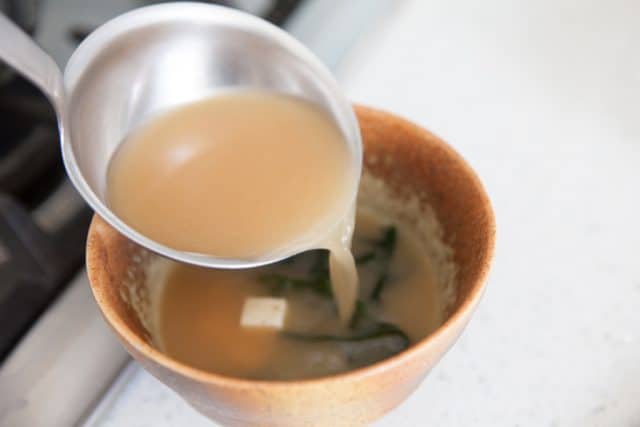
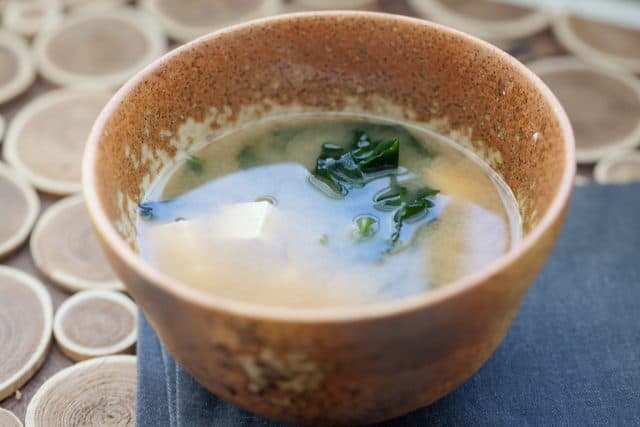
Types of Miso Paste
There are many different types of miso paste that you can use for this miso ramen recipe. You can lump them into 3 different categories: White, Yellow and Red.
- White miso paste (shiro) is made from fermented soybeans and rice. It’s the mildest and sweetest miso.
- Yellow miso paste (shinsu) is made from fermented soybeans and barley. It’s fermented longer than white miso, and is saltier.
- Red miso paste (aka) is made from fermented soybeans and most often, barley. It is the most salty, strong tasting miso.
White miso, or shiro miso is my favorite. It’s lighter and less of a salty flavor than other kinds of miso. I love the delicate flavor! We use this for our Miso Salmon recipe. I find that the red miso is too strong for my palate.
Not only do I use white miso for making Japanese style noodle soups, but if I’m making any kind of soup that needs a kick of flavor, I’ll stir in a big tablespoon of miso paste, which is a natural umami-master. It will add a savory, salty, slightly sweet flavor boost to anything! (Pssst….I even add it to mashed potatoes!)
There’s also miso that has dashi mixed into the paste…which is what we used for the 3-minute miso recipe above. Look at the package very carefully, it will say one of these things:
- Seasoned Miso
- Miso with Bonito
- Miso with Dashi
Most miso paste in stores are sold in plastic tubs or plastic bags. I prefer the tubs, because miso paste can be stored in the refrigerator for up to 6 months, it is easier to store in the tub.
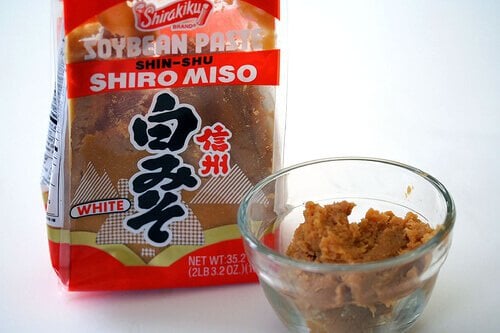
To store miso paste, press plastic wrap directly over the miso. Try to cover the miso so that air does not dry out the paste.
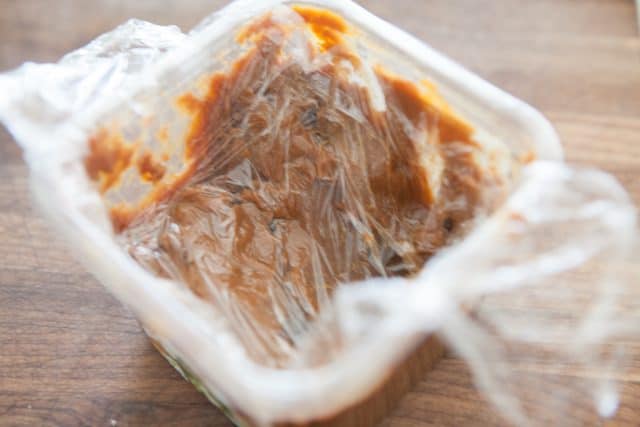
This is easiest using an airtight container. Simply cover with lid and refrigerate. Stored properly, miso should last about 6 months in the refrigerator.
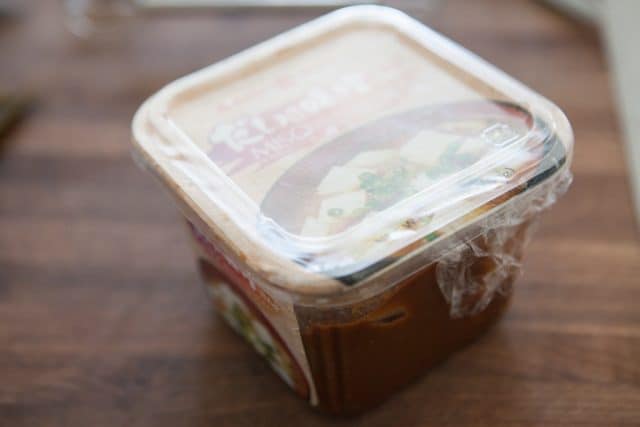
Top Tips For These Miso Soup Recipes
- There are many different types of miso paste that you can use for this miso ramen recipe. You can lump them into 3 different categories – from mildest to strongest: White, Yellow and Red.
- Miso paste can be stored in the refrigerator for up to 6 months, it is easier to store in the tub.
- Spent katsuobushi (along with the used kombu) can be re-used to make secondary dashi, which is a weaker tasting dashi that can be used for many Japanese dishes.
- No MSG is needed when you use kombu!
More Recipes That Use Miso Paste
- Miso Salmon
- Miso Almond Sauce (dressing, dipping sauce, toss with noodles)
- Chicken Salad with Sesame Miso Dressing
- Miso Butter Shrimp Appetizer
- Rachael’s Gyoza
- Japanese Noodles with Shimeji Mushroom
- Grilled Miso Tenderloin
- Sake Miso Marinated Butterfish
Have you tried these Miso Soup Recipes? Feel free to leave a star rating and I’d love to hear from you in the comments below!
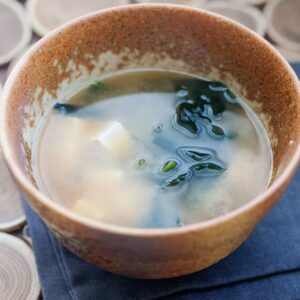
Miso Soup from Scratch
Ingredients
- 4 cups water
- 1 piece kombu 4"x6" piece kelp
- 1 ounce katsuobushi bonito flakes
- 3 tablespoon miso paste
- 4 ounces tofu
- 1 tablespoon dried wakame seaweed
Instructions
- Wipe the kombu clean with a paper towel. Add the kombu and water to a sauce pan. Bring to a boil over medium-low heat. When water just begins to boil, remove the kombu.
- Bring the kombu water to full boil. Add the katsuobushi all at once. Boil for 60 seconds. Turn heat off and let sit, undisturbed for 10 minutes.
- in the meantime, dice the tofu. Soak dried wakame in water until expanded. drain and discard water.
- After steeping katsuobushi, the flakes will sink to bottom of pot. Strain the katsuobushi through cheesecloth.
- Return dashi to a simmer and immediately turn off heat. Whisk in miso paste. When miso has fully dissolved, add tofu and wakame.

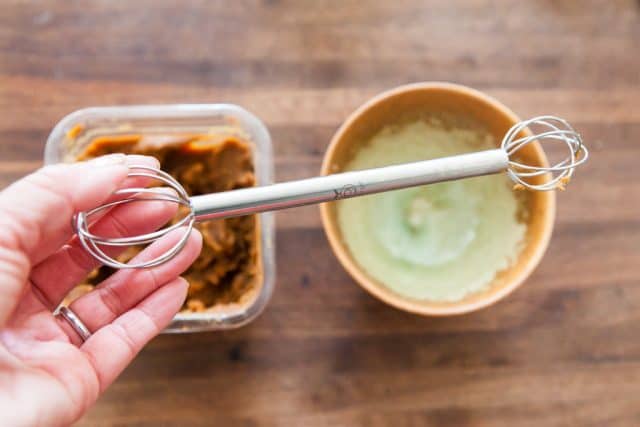




How do I get rid of the super fishy smell from the seaweed once I h e rehydrated it?
Hello! My mom bought one of the packs of 32 Mirokume brand. The expiration date seems to be April 2020 and she doesn’t think she can use that much that quickly. Can you freeze the packets of miso paste?
Hi Lynne – yes you can freeze, or you can put the miso packets in the refrigerator.
You really should look up the history of MSG and how it’s actually a myth that’s its bad for you. Its just 1 part gluten and 1 part sodium, that’s it. So unless yr allergic to gluten, which is actually pretty rare, you’re fine. Turns out the whole MSG thing came about due to racism against the Asians back in the day. Crazy story, google it 🙂
MSG does not contain gluten. MSG stands for monosodium glutamate. Glutamate (or glutamic acid) is an amino acid. There is absolutely NO link between glutamate and gluten. For instance, glutamate is found in every single meat (all meats provide the complete assortment of 20 amino acids, glutamate included). Gluten is found in wheat (and some other grains). By your logic, someone with a gluten sensitivity would not be able to eat any meat.
hi. where did you purchase the miso tool please?
Hi Connie – You can buy on Amazon: http://amzn.to/2zJZjV3
Really like your recipe – I needed to halve it. It would be less messier if you had a gram unit of weight for the miso instead of a cup measurement. That way we can just glob it out instead of shoving it in a cup.
So glad to have this recipe – thanks!
Hi! just attempted to make this, but didn’t want to make a huge pot. Also, I didn’t have over half the ingredients haha. But I did have miso paste, frozen veggie stock (I keep all of my stock), and chicken bullion cubes. I did 1 bullion cube, 3 cups of water and 1/2 cup of veggie broth. I added 1 tbs miso. It was great. I’m going to get tofu and seaweed next time I go to town 🙂
I need to try this! This is the simplest recipe I’ve found so far.
I added two cans of water chestnuts, some spinach, and book choy. Im did 4 sheets of seaweed, and doubled the recipe. Added some thin rice noodles too!
I tried this recipe and it was amazing!!! However, I used different product brands and it turned out perfect, not too salty, JUST PERFECT! I wish I could post the pictures of the products I used because I was limited to the choices of product brands.
hi there. where can i buy the dashi granules and also the seaweeds? im such a newbie in cooking. thanks a lot. more power!
Hi Gary – you can find them at a local Asian market (just search “Asian market” in google maps.) The best thing to do is print out this post, and then you’ll have a photo to show the clerk. Alternatively, you can purchase on Amazon – the price is actually very good – very similar to what I pay at the store! Here is the dashi and the seaweed.
About the dried sea weeds, are they similar to Wakame?
Hi Dave – yes wakame is Japanese for the type of seaweed to use in Miso Soup.
what type of noodles would you recommend in place of or in addition to the seaweed? I love noodles…
Hi there – I like using skinny rice noodles or glass noodles (clear, skinny Asian noodles)!
I think my ex took my Miso Soup Recipe! I haven’t made this in a while. I found this recipe and it is great! I just wanted to confirm the ratio of Miso Paste and Dashi to use and I am glad I did. I think I would have used way too much of each. With that said, I still like a strong Miso Soup so I still went a little heavy on the Dashi and I use the Red Miso paste which is a bit bolder in flavor as well. I just use whatever leafy greens I have in fridge so tonight it was organic mixed baby lettuce. Tasted great. Saved to my favorites for future reference if I need it.
Just made this and it was a huge success. Had to use chicken bouillon as I am living outside the U.S. and the other products weren’t available. But anyway, it was delicious and the whole family loved it!
Loved the Prozac laced seaweed comment. I will try your recipe!
This was way too salty, had to add 2 extra cups of boiled water to make it edible.
Next time I think I will be using 1/4 cup of miso paste instead…
Hi Lauren! Oh my goodness, you’re right! Thanks for pointing that out.
Love this! Thank you!
Hi,
I was wondering if you knew about the minute miso product and if there is a difference between that and the miso paste? I bought both but u noticed the paste didn’t break up and dissolve as easily.
Do you drain your tofu before using it in the soup? And what texture do you usually use – soft, firm, etc?
Yes, if there’s extra water.
I love all types of tofu – for soup, I like soft. But for stir fries or anything going into a pan, I’ll get firm or extra firm.
I tried the recipe and loved it, thanks a lot!
The first time, I used the Tofu as is, but the second time I followed instructions to wrap it in kitchen towels and put pressure on it through a cutting board and a can. I thought it had much more flavor as I assume the weight drains the Tofu’s water, which is then reabsorbed in the soup.
Hi,
Just wondered as I’m new to cooking with miso paste, can it be added to stir-fries to season with?
Or can it only be used in soup?
Thanks,
Mala.
Yes! You can add to stir fries. Just add teaspoon at a time, miso is salty.
1/2 cup of miso paste to only 4 cups of water? This would be soooooooooooooo salty!!!!
I don’t typically write remarks, nonetheless I looked through a
bunch of responses here on Simple 10-Minute Miso Soup | Steamy Kitchen Recipes and had a couple of important questions for you if you wouldn’t mind.
Could it be just me or do quite a few of these replies appear
to be as if they could be generated from brain dead visitors?
As well, in case you are publishing on some various blogs,
I would like to keep up with you. Is it possible to put up a listing of all
your social networking sites like your linkedin user profile, Facebook
url page or twitter feed?
Thank you for the pictures of the ingredients!
Great recipe but I think it might help to add how salty these ingredients are. I followed your recipe step by step and found the soup to be too salty. Maybe suggest that readers try to find low sodium products if possible? Even the dried seaweed was pretty salty without the dashi and miso paste.
Other than that, your recipe was very easy to follow. Thanks for your post!
Hi Jaden, I just wanted to let you know that we shared your great recipe on our site. We have given full credit and provided a linkback to steamykitchen. Keep up the great work!
~ Angel
I am thinking that the miso soup I have had in the past,didn’t have seaweed in it. I am not sure my kids would like that, so can you tell me if that would change the overall flavor if left out?
spinach
Hi Chieko,
I went into an Asian grocery store yesterday to buy the dashi granules and when I read the ingrediants I was disappointed to see salt and MSG, so I asked and the owner told me I could make my own using Kombu and Dried Bonito Shavings with no MSG. So that is what I bought instead. I have organic miso and tofu I sure don’t want those other ingrediants…hope it turns out good. I was happy to read your post, I actually stopped there maybe someone else mentioned it prior I don’t know but I was glad to see someone else noticed the not so great ingrediants in dashi granules.
did you know that Kombu is a natural source of monosodium glutamate? i just wanted to let you know that. lolz…
LOL! Like that all of a sudden makes MSG non-toxic! ALL glutamates should be avoided. They are called “Excito-toxins”. Basically they over stimulate brain cells and burn them out.
Where’s the proof of Msg being toxic then? can you send me a link?
You have no idea what your talking about!!
MSG is merely a flavour enhancer just like salt.
With due respect, MSG is an artificial flavouring which is composed of glutamate which overworks the brain… that makes it no different to poison or toxic. If u know why saccharine was banned, then u will understand why we prefer to avoid MSG
I can’t tell if you’re being serious or not. Glutamate is the most common neurotransmitter in humans.
Glutamate is the major excitatory neurotransmitter in the vertebrate brain. It is present in all ingested proteins and is produced naturally by all cells in the body. MSG is one synthetic salt of glutamate and dissociates in solution (water) into sodium and glutamic acid. It tastes yummy and is one of the reason we like to eat mushrooms, beef, broccoli, and kombu.
amen
Then you’re going to need to eliminate an awful lot of foods from your diet. You can start with miso paste. It occurs there naturally, so you won’t see it in the ingredients list because it’s not something that’s been added.
For questions about MSG vs. glutamine vs. glutamate, this article explains them all in the context of athletic performance: http://www.hammernutrition.com/downloads/msg.pdf
This is my default miso soup recipe. I have been using it for a few years since I found it. Always a success.
Just made this. Good stuff man!! 5 stars!!
…posting *about it* one way or another. Thanks for sharing!
This looks fantastic! I’ve been searching for an easy way to make miso soup at the office…where all I have is a microwave. I’m going to try this by boiling water, adding the dashi, another 30 seconds, then tofu and seaweed, another 30 seconds, then miso paste and green onions…then, eat up! I hope it works…I will be posting one way or another. 🙂
I love that you include pictures of the products. Now when I go to the international market I will be able to identify what I want. Most of the time the packages and other labels are not in english and I don’t know what to get.
Yummy! I got hungry just by reading your instructions on miso soup. I always order a bowl everytime I eat at Japanese restaurants. In fact I just ordered one for dinner last time along with my bento box of beef misono. I just got disappointed last night because the soup isn’t hot. Now that I know how to prepare one I think I’ll just make it myself here at home. Kudos!
can you cook this soup in a slow cooker
One question, when do you put the tofu in? It is in the ingredients, but not the recipe.
My next door neighbor just had surgery and her throat is sore and swollen. I am trying to come up with recipes that will be nourishing, tasty, and easy for her to swallow. She is a bit picky but her boyfriend is also half Japanese so I figured she’d had miso soup before. I had only made it at home from a packet. Searched the web for a recipe, happened to find your site, and now I will NEVER make it from a packet again. So tasty!! And she loved it. Thank you for posting the recipe. Bonus points as I had a jar of Hon-Dashi and was wondering how to use it up just a bit faster. I did increase the HD to 2 t. and dropped the miso to 3-4 T. to help decrease the sodium. Also added 1 t. of pan-toasted sesame seeds, which gave a nice flavor. With the leftover tofu, I made the Chilled Tofu w/Scallions from 15 Spatulas that you linked to. Excellent. Now I am _craving_ tofu. I did not think that was possible, hahaha.
I love your posts! Just to mention, another reason to not overheat the miso paste is that by doing so the beneficial bacteria and enzymes are destroyed!
Ingredients in Hon-Dashi: salt, monosodium glutamate, lactose, sugar, dried bonito powder, disodium inosinate, bonito extract, yeast extract, disodium succinate.
Notice the first ingredient is salt! I’d recommend making your own dashi which is not salty at all. I make mine with shiitake mushrooms which adds a complementary taste to the finished miso soup.
Hi there!
I just made this for my Sunday lunch. Great recipe, but I do feel that the soup is a little too salty, so I’d reduce the amount of miso paste/dashi or increase the water, for my tastes. Otherwise, I feel really good about making and consuming it! Thanks 🙂
This recipe has the best description – especially since most people aren’t familiar with the ingredients. Great job!
I ordered a tub of miso paste from amazon. How do I make siup with this?
Thanks!
This is my first experience with miso. I loved it! The soup was quick to prepare, delicious & a great way to get this healthy fermented food in my diet.
Hello! So very excited to have found this miso recipe! I’m trying it tonight, I bought some Dashi this afternoon and in my excitement I forgot to ask the lovely lady in the Asian grocery store to translate the instructions for me!
I have miso before but without the Dashi so will post you my feedback in the next few days.
Cheers Bella 🙂
Hello,
You are a wonderful cook and so beautiful! I am glad that I have found an excellent site to learn new recipes.
did this soup just now (used homemade dashi by the way, and mashed some salted soybeans to make the miso). and it turned out GREAT! am enjoying my second bowl now 😀 thanks for your lovely and simple recipe and instructions! been craving for miso soup 🙂 and making it myself is much more fun and yummier!
Thank you!
This recipe is so clearly written and easy to follow that I was emboldened to try it and I’m so glad I did! It has become a regular on our dinner table. Yummy!
I just made this and it came out really salty so I added an additional cup and a half or so of water and it was better. I can’t tell exactly why?
But anyway, great recipe, thanks!
I tried this recipe last night — it was perfect! I’ve been eating miso out of those just-add-water packets, and there’s no comparison.
I used homemade dashi, though– it’s actually no more difficult than using instant dashi. For the homemade deal, all you do is throw a few strips of kombu into water and bring it to a boil, then just before it boils, remove the kombu. Then if you want you can toss in some katsuobushi (bonito flakes) for ten seconds, then drain. That’s it.
Basically, you’re just boiling water, same as the instant version.
One question: the one thing that *wasn’t* great about this recipe was my tofu. I didn’t get organic, but I don’t think that’s the problem. I got a plain block of tofu, chopped it up and tossed it in. It tasted nothing like what you normally find in miso in a restaurant. Do you know if restaurants prepare the tofu in any way?? Is there a type of tofu I should watch out for? Thanks!
If you like silky tofu, try soft tofu. If you like reallllly silky tofu, get this: http://www.morinu.com/store/page3.html
Just started eating Miso soup and minus the tofu this looks like a great recipe. I know Miso is really good for you.
I love your commentary (sense of humor) in “Simple 10-min Miso Soup” in addition to the recipe tips. I’ve been sort of “winging it” all these years but after making it for dinner last night, I figured there must be a recipe on the web that tell how much instant dashi to use. (the dashi packages I hve are only in Japanese because my Mom sent them from Tokyo when they lived there). Thanks again!
Oh how i love you and your blog…………oh oh how much i do…….thank you for this recipe and the pictures are awesome….
MMmmmmmmmmmWUAH!!!!
Thanks for this great recipe! I just made some now and it is fantastic!!
Thats some good miso, first time making it and it tastes almost exactly like the best japanese restaurant ive ever been to 🙂
2 questions…
Where can I get a set of your bowls? Those look nearly indestructible!
Also, when you say to use seaweed, are you using the dried algae/nori sheets for sushi just chopped up? Or are you actually using seaweed?
Your miso soup looks good. Miso soup is one of my favorites. I was using the dashi no moto for a long time. Then I discovered that making the dashi from konbu and bonito flakes was pretty easy. If you always have a supply of dashi in your fridge then it still only takes a few minutes to make the miso soup.
Your spoon and bowl look really interesting/good.
Thanks for the recipe. Am giving it a go this evening though I’ll be using miso paste with dashi included in it – can’t read Japanese either but the label at the supermarket pointed it out.
Ivon- Use vegetable stock that is diluted…it will taste just as good…and definitely healthy!
Hi,
First of all, this page is the only page that I could find in Google that best describe and explain how to make miso soup.
Many many thanks, I definitely bookmark this page.
Just a question however, my siblings are vegan, will the taste be very bad if we do not have the Dashi?
Dondon- certainly. the only must haves are miso and dashi. The rest are “condiments”
can you make make miso soup without tofu
Cindy- well its probably special order from a shady seaweed dealer
Happy Homebaker- Thank you! I think you are such a talented baker – would love to try the chocolate marble bread. I think my kids would love it.
Hi, you have a very beautiful blog!
I am gonna try your miso soup…it looks easy enough for me, and I should be able to get all the ingredients…thanks for sharing your recipe =)
yes, i am wondering where to buy that “seaweed fortified with prozac”! ;] but seriously, i do want to try this recipe too!
Tigerfish- I was desperate once and used diluted ckn stock, it was ok, not bad and fixed my craving.
Anh- It is so healthy that I think I should have some every day too. Maybe miso soup instead of bfast?
Melinda- you are too kind!
Amy- thank you!
Gotta love happy faces! 😀 I love this recipe and all the product recommendations. I’m going to bookmark this. Thanks Jaden!
I wish I was content enough to read your posts without commenting…you know, just blurking. But you are just too much fun not to write and say how much I enjoyed this post.
I’ve wanted to make my own miso soup but wasn’t sure what exactly was needed. I love the prozac paste. I must search to find exactly that brand here in England. I want a happy face too.
Jaden, this is exactly how I made miso almost everyday! And Shiro Miso is my top fav, too. 🙂 Always have some on hand.
This miso soup looks really authentic (bowl and spoon, included) 😀
I wonder if it will taste as authentic if I use chicken stock. The Shiro Miso you recommended sounds worthy. Let me check out my nearby korean grocer. :p Thks!
There’s a chain Japanese restaurant in my area that offers something called miso soup, but it’s nothing but chicken broth with a chemical aftertaste. There’s no substitute for authentic miso soup. I like to add firm tofu cubes and a little of something green, like green onions, spinach or snow peas. It’s quick and hits the spot when you’re tired or under the weather.